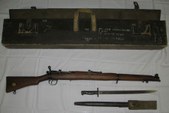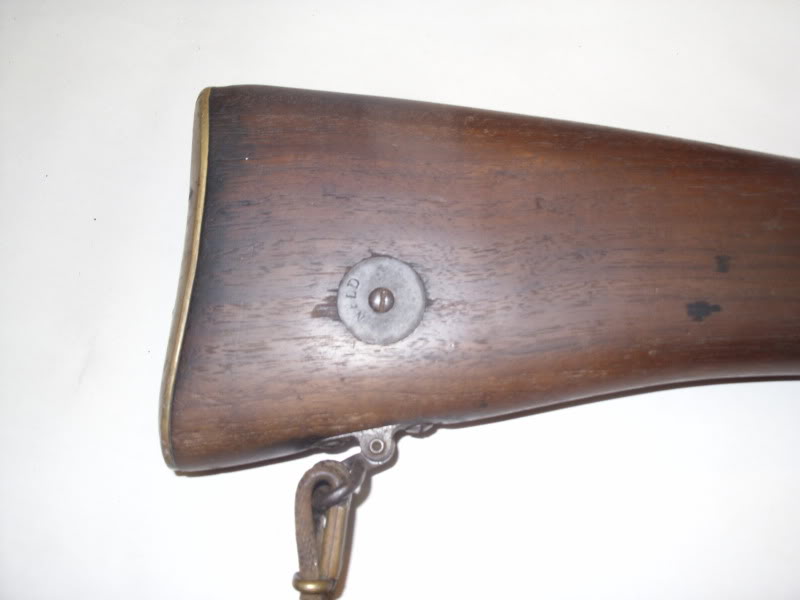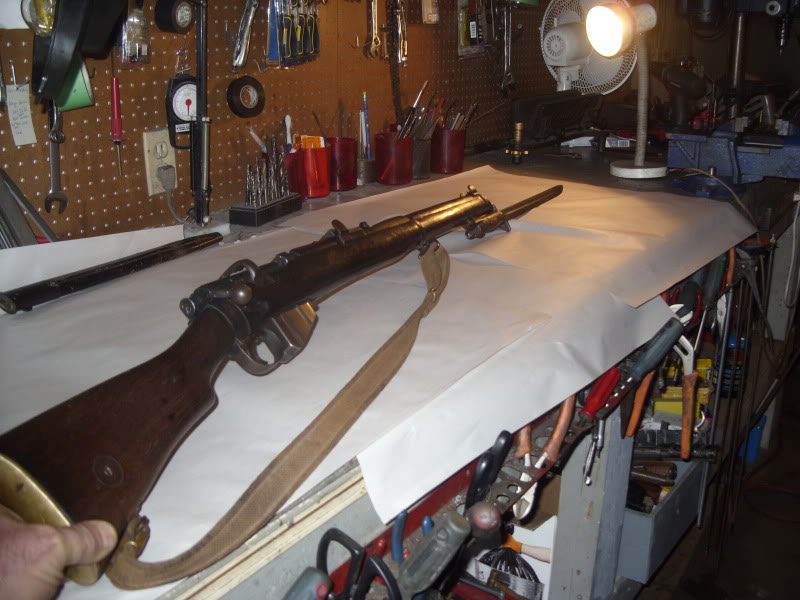-
 Lee Enfield used by the Newfoundland Regiment in WW1
Lee Enfield used by the Newfoundland Regiment in WW1
This rifle was issued to the Newfoundland Regiment in 1918. The rifle entered the Church Lad's Brigade collection when it was donated to the brigade in the wake of the fire that claimed their armoury.
 (Click PIC to Enlarge)
(Click PIC to Enlarge)
Note: After you click on images to ENLARGE them, you may find they automatically size smaller in your browser's window making them harder to view. The auto sizing is your browser's way of keeping images entirely within the screen size you have set. Move your mouse pointer to the bottom center of the pic and you will see an options panel appear. There will be a small square box next to the large X, which will have a pointer arrow sticking out of it. If it's illuminated, it means the pic you're viewing can be enlarged, so click on this box and the pic will EXPAND and open to its normal size.
Description: This artefact is a case containing a 1918 British No. 1 MKIII Short Magazine Lee
Enfield Rifle
and 1917 Wilkinson Enfield bayonet. The Case is of a wooden construction that has been painted green, with metal hinges and khaki cloth handles. The front of the case contains white stencilled lettering that informs of the shipping information. It reads "TO- OFFICER COMMANDING 9 AOD ST. JOHN'S NFLD. FROM -25 COD MONTREAL." The reverse bears the same inscription. The top of the case also bears the same inscription but contains the marking I.V. A-125695. The Left end of the case shows a serial number of IL 9636, while the right end states "CASE NO 3 OF 4 T 25 CV 118. The Rifle is comprised of a blued metal barrel, action, bolt, magazine, trigger and trigger guard, and bayonet mount. The majority of the rifle is encased in a dark wood that runs the length of the weapon from muzzle to stalk. The bolt, that forms the rifles firing action, is worked by a lever that faces to the right. The lever must be rotated up before the bolt can slide back. Under the muzzle of the rifle is a flat disk over which the bayonet ring is placed. The stock is capped by a brass end that has a small circular opening covered by a brass door. Under the door is a void in which the rifle's cleaning equipment is stored. A brass disk bearing the marking "N.F.L.D.' has been screwed to the right side of the stalk. The Rifle contains the British Government markings of an arrow and a crown at numerous points on the weapon. The weapon also contains the maker's information on the trigger guard below the bolt which reads "G.R. B.S.A. co. 1918 SHT. L.E. III*." The Bayonet is single edged with a broad back edge that narrows to a thin cutting edge. The tip of the blade is curved from the cutting edge to the back edge. The blade also contains an oval depression that runs the length of the blade on both sides. Under the depression appears a crown and "G.R. 1907 II 17 Wilkinson." The blade runs through the cross guard, where two wooden hand grips have been attached by way of two screws. The end of the bayonet is formed by a cast metal piece that contains a spring loaded locking mechanism that helps keep the bayonet attached to the rifle. The scabbard has been formed from a single piece of leather that has been folded and stitched down the back, to which a metal end cap and collar have been attached.
Narrative: When war was declared by the British in 1914 and Newfoundland had offered forth its war time commitment, the island quickly set about recruiting, equipping, and training men for service in the Newfoundland Regiment. The Church Lad's Brigade armoury on Harvey Road in St. John's was established as the headquarters of the Newfoundland Regiment, and the men who made up the ranks of the regiment in 1914 all reported to the armoury to enlist. The equipment committee of the Newfoundland Patriotic Association placed an order with the Canadian Government for a number of military items, which included 500 Canadian Ross Rifles, to equip the men for overseas service. The rifles had not reached the island by 3 October 1914 when the first contingent of the Newfoundland Regiment set sail for further training in
England
. Upon their arrival in England the Regiment was equipped with the British No.1 MKIII .303 Small Magazine Lee Enfield, which was the standard British Army rifle. From that point to the close of the war, the Newfoundland Regiment was issued with the Enfield. The British Enfield was produced by a number of firms throughout its service in the Army between 1907 and 1944. The Birmingham Small Arms Company or B.S.A. Co. was established in 1861 at Small Heath just outside Birmingham. During the time they produced the No. 1 MK III the company manufactured nearly two million. Many regiments and organizations used the No. 1 MKIII and it was common practice to stamp regimental identification marks on the brass stock disk. The N.F.L.D. of this rifle's stock disk identifies it as a rifle of the Newfoundland Regiment prior to the official name change of the regiment in 1918. After the addition of Royal to the Newfoundland Regiment in 1918 the stock disks on Enfield's produced for the regiment read 1RNR.
History of Use: This rifle was issued to the Newfoundland Regiment in 1918. The rifle entered the Church Lad's Brigade collection when it was donated to the brigade in the wake of the fire that claimed their armoury.
Artefacts Canada - The Professional Exchange
Regards,
Doug
Information
 |
Warning: This is a relatively older thread
This discussion is older than 360 days. Some information contained in it may no longer be current. |
|
Last edited by Badger; 04-07-2016 at 08:00 AM.
-
Thank You to Badger For This Useful Post:
-
12-27-2010 07:32 AM
# ADS
Friends and Sponsors

-
Legacy Member

Some pics of my Newfoundland marked SMLE.Anybody have one marked 1RNR??


-
The Following 3 Members Say Thank You to superbee For This Useful Post:
-
Contributing Member


Badger, I am surprised the narrative does not mention Beaumont Hamel 1st July 1916.
-
-
Legacy Member

Superbee, IF I had known you had that rifle the trade for #1 would have been different...LOL...just kidding but would I love one of those. Been to Beaumont Hamel and after that visit have even more interest in the NL Regiment.
Why use a 50 pound bomb when a 500 pound bomb will do?
-
-
FREE MEMBER
NO Posting or PM's Allowed

I have a disc marked 2RNC with the # 28. Always wondered if it was Newfoundland related. Not in any books I have, and google don't help either.
-

Originally Posted by
RobD

Badger, I am surprised the narrative does not mention Beaumont Hamel 1st July 1916.
Me too ...
My wife and I are planning a visit there next September, along with Vimy Ridge and The Somme. 
Regards,
Doug
-
-
Contributing Member


Doug, I can recommend an excellent B&B,
Bernafay Wood B&B, Somme
Personally, I would recommend visiting the Somme battlefields on bicycle, as the distances are small and the forests (woods) which you can cycle through are still filled with trenches and shell holes. A car sort of alienates one from the place.
-
Thank You to RobD For This Useful Post:
(Click PIC to Enlarge)
and 1917 Wilkinson Enfield bayonet. The Case is of a wooden construction that has been painted green, with metal hinges and khaki cloth handles. The front of the case contains white stencilled lettering that informs of the shipping information. It reads "TO- OFFICER COMMANDING 9 AOD ST. JOHN'S NFLD. FROM -25 COD MONTREAL." The reverse bears the same inscription. The top of the case also bears the same inscription but contains the marking I.V. A-125695. The Left end of the case shows a serial number of IL 9636, while the right end states "CASE NO 3 OF 4 T 25 CV 118. The Rifle is comprised of a blued metal barrel, action, bolt, magazine, trigger and trigger guard, and bayonet mount. The majority of the rifle is encased in a dark wood that runs the length of the weapon from muzzle to stalk. The bolt, that forms the rifles firing action, is worked by a lever that faces to the right. The lever must be rotated up before the bolt can slide back. Under the muzzle of the rifle is a flat disk over which the bayonet ring is placed. The stock is capped by a brass end that has a small circular opening covered by a brass door. Under the door is a void in which the rifle's cleaning equipment is stored. A brass disk bearing the marking "N.F.L.D.' has been screwed to the right side of the stalk. The Rifle contains the British Government markings of an arrow and a crown at numerous points on the weapon. The weapon also contains the maker's information on the trigger guard below the bolt which reads "G.R. B.S.A. co. 1918 SHT. L.E. III*." The Bayonet is single edged with a broad back edge that narrows to a thin cutting edge. The tip of the blade is curved from the cutting edge to the back edge. The blade also contains an oval depression that runs the length of the blade on both sides. Under the depression appears a crown and "G.R. 1907 II 17 Wilkinson." The blade runs through the cross guard, where two wooden hand grips have been attached by way of two screws. The end of the bayonet is formed by a cast metal piece that contains a spring loaded locking mechanism that helps keep the bayonet attached to the rifle. The scabbard has been formed from a single piece of leather that has been folded and stitched down the back, to which a metal end cap and collar have been attached.
. Upon their arrival in England the Regiment was equipped with the British No.1 MKIII .303 Small Magazine Lee Enfield, which was the standard British Army rifle. From that point to the close of the war, the Newfoundland Regiment was issued with the Enfield. The British Enfield was produced by a number of firms throughout its service in the Army between 1907 and 1944. The Birmingham Small Arms Company or B.S.A. Co. was established in 1861 at Small Heath just outside Birmingham. During the time they produced the No. 1 MK III the company manufactured nearly two million. Many regiments and organizations used the No. 1 MKIII and it was common practice to stamp regimental identification marks on the brass stock disk. The N.F.L.D. of this rifle's stock disk identifies it as a rifle of the Newfoundland Regiment prior to the official name change of the regiment in 1918. After the addition of Royal to the Newfoundland Regiment in 1918 the stock disks on Enfield's produced for the regiment read 1RNR.


















 PM
PM











